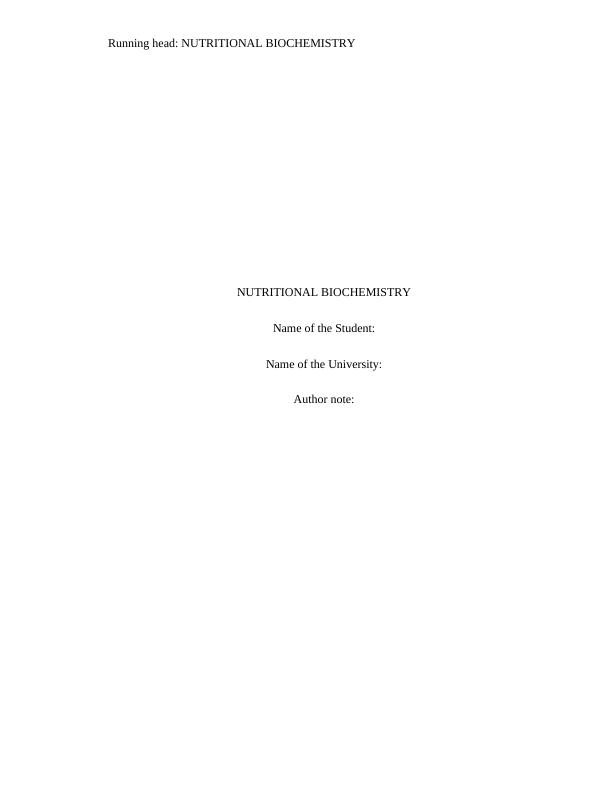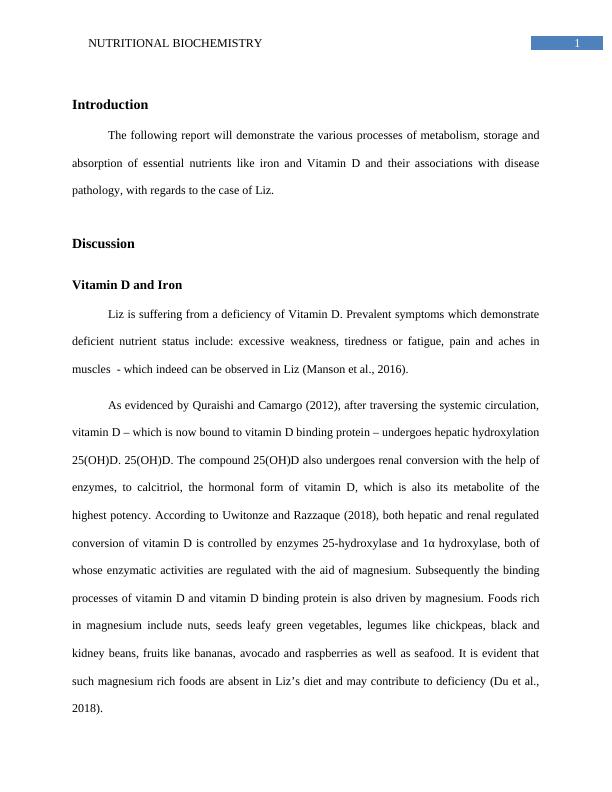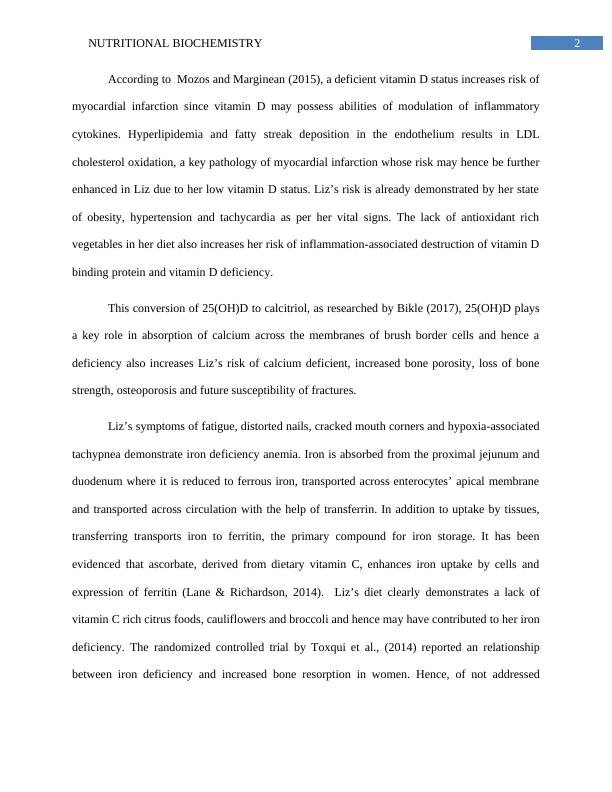Report | Nutritional Biochemistry
Added on 2022-10-04
7 Pages1501 Words14 Views
Running head: NUTRITIONAL BIOCHEMISTRY
NUTRITIONAL BIOCHEMISTRY
Name of the Student:
Name of the University:
Author note:
NUTRITIONAL BIOCHEMISTRY
Name of the Student:
Name of the University:
Author note:

1NUTRITIONAL BIOCHEMISTRY
Introduction
The following report will demonstrate the various processes of metabolism, storage and
absorption of essential nutrients like iron and Vitamin D and their associations with disease
pathology, with regards to the case of Liz.
Discussion
Vitamin D and Iron
Liz is suffering from a deficiency of Vitamin D. Prevalent symptoms which demonstrate
deficient nutrient status include: excessive weakness, tiredness or fatigue, pain and aches in
muscles - which indeed can be observed in Liz (Manson et al., 2016).
As evidenced by Quraishi and Camargo (2012), after traversing the systemic circulation,
vitamin D – which is now bound to vitamin D binding protein – undergoes hepatic hydroxylation
25(OH)D. 25(OH)D. The compound 25(OH)D also undergoes renal conversion with the help of
enzymes, to calcitriol, the hormonal form of vitamin D, which is also its metabolite of the
highest potency. According to Uwitonze and Razzaque (2018), both hepatic and renal regulated
conversion of vitamin D is controlled by enzymes 25-hydroxylase and 1α hydroxylase, both of
whose enzymatic activities are regulated with the aid of magnesium. Subsequently the binding
processes of vitamin D and vitamin D binding protein is also driven by magnesium. Foods rich
in magnesium include nuts, seeds leafy green vegetables, legumes like chickpeas, black and
kidney beans, fruits like bananas, avocado and raspberries as well as seafood. It is evident that
such magnesium rich foods are absent in Liz’s diet and may contribute to deficiency (Du et al.,
2018).
Introduction
The following report will demonstrate the various processes of metabolism, storage and
absorption of essential nutrients like iron and Vitamin D and their associations with disease
pathology, with regards to the case of Liz.
Discussion
Vitamin D and Iron
Liz is suffering from a deficiency of Vitamin D. Prevalent symptoms which demonstrate
deficient nutrient status include: excessive weakness, tiredness or fatigue, pain and aches in
muscles - which indeed can be observed in Liz (Manson et al., 2016).
As evidenced by Quraishi and Camargo (2012), after traversing the systemic circulation,
vitamin D – which is now bound to vitamin D binding protein – undergoes hepatic hydroxylation
25(OH)D. 25(OH)D. The compound 25(OH)D also undergoes renal conversion with the help of
enzymes, to calcitriol, the hormonal form of vitamin D, which is also its metabolite of the
highest potency. According to Uwitonze and Razzaque (2018), both hepatic and renal regulated
conversion of vitamin D is controlled by enzymes 25-hydroxylase and 1α hydroxylase, both of
whose enzymatic activities are regulated with the aid of magnesium. Subsequently the binding
processes of vitamin D and vitamin D binding protein is also driven by magnesium. Foods rich
in magnesium include nuts, seeds leafy green vegetables, legumes like chickpeas, black and
kidney beans, fruits like bananas, avocado and raspberries as well as seafood. It is evident that
such magnesium rich foods are absent in Liz’s diet and may contribute to deficiency (Du et al.,
2018).

2NUTRITIONAL BIOCHEMISTRY
According to Mozos and Marginean (2015), a deficient vitamin D status increases risk of
myocardial infarction since vitamin D may possess abilities of modulation of inflammatory
cytokines. Hyperlipidemia and fatty streak deposition in the endothelium results in LDL
cholesterol oxidation, a key pathology of myocardial infarction whose risk may hence be further
enhanced in Liz due to her low vitamin D status. Liz’s risk is already demonstrated by her state
of obesity, hypertension and tachycardia as per her vital signs. The lack of antioxidant rich
vegetables in her diet also increases her risk of inflammation-associated destruction of vitamin D
binding protein and vitamin D deficiency.
This conversion of 25(OH)D to calcitriol, as researched by Bikle (2017), 25(OH)D plays
a key role in absorption of calcium across the membranes of brush border cells and hence a
deficiency also increases Liz’s risk of calcium deficient, increased bone porosity, loss of bone
strength, osteoporosis and future susceptibility of fractures.
Liz’s symptoms of fatigue, distorted nails, cracked mouth corners and hypoxia-associated
tachypnea demonstrate iron deficiency anemia. Iron is absorbed from the proximal jejunum and
duodenum where it is reduced to ferrous iron, transported across enterocytes’ apical membrane
and transported across circulation with the help of transferrin. In addition to uptake by tissues,
transferring transports iron to ferritin, the primary compound for iron storage. It has been
evidenced that ascorbate, derived from dietary vitamin C, enhances iron uptake by cells and
expression of ferritin (Lane & Richardson, 2014). Liz’s diet clearly demonstrates a lack of
vitamin C rich citrus foods, cauliflowers and broccoli and hence may have contributed to her iron
deficiency. The randomized controlled trial by Toxqui et al., (2014) reported an relationship
between iron deficiency and increased bone resorption in women. Hence, of not addressed
According to Mozos and Marginean (2015), a deficient vitamin D status increases risk of
myocardial infarction since vitamin D may possess abilities of modulation of inflammatory
cytokines. Hyperlipidemia and fatty streak deposition in the endothelium results in LDL
cholesterol oxidation, a key pathology of myocardial infarction whose risk may hence be further
enhanced in Liz due to her low vitamin D status. Liz’s risk is already demonstrated by her state
of obesity, hypertension and tachycardia as per her vital signs. The lack of antioxidant rich
vegetables in her diet also increases her risk of inflammation-associated destruction of vitamin D
binding protein and vitamin D deficiency.
This conversion of 25(OH)D to calcitriol, as researched by Bikle (2017), 25(OH)D plays
a key role in absorption of calcium across the membranes of brush border cells and hence a
deficiency also increases Liz’s risk of calcium deficient, increased bone porosity, loss of bone
strength, osteoporosis and future susceptibility of fractures.
Liz’s symptoms of fatigue, distorted nails, cracked mouth corners and hypoxia-associated
tachypnea demonstrate iron deficiency anemia. Iron is absorbed from the proximal jejunum and
duodenum where it is reduced to ferrous iron, transported across enterocytes’ apical membrane
and transported across circulation with the help of transferrin. In addition to uptake by tissues,
transferring transports iron to ferritin, the primary compound for iron storage. It has been
evidenced that ascorbate, derived from dietary vitamin C, enhances iron uptake by cells and
expression of ferritin (Lane & Richardson, 2014). Liz’s diet clearly demonstrates a lack of
vitamin C rich citrus foods, cauliflowers and broccoli and hence may have contributed to her iron
deficiency. The randomized controlled trial by Toxqui et al., (2014) reported an relationship
between iron deficiency and increased bone resorption in women. Hence, of not addressed

End of preview
Want to access all the pages? Upload your documents or become a member.
Related Documents
Nutrition and Biochemistry: Iron and Vitamin D Statuslg...
|8
|1834
|59
